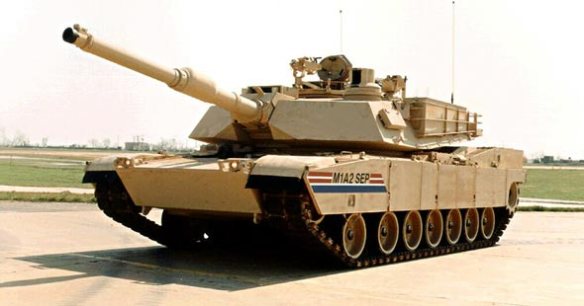
M-1A2 SEP
Ford 3-Ton M1918, Six Ton Tank M1917(License built Renault FT), Tank Mark VIII Liberty.
The production of armored vehicles is a highly specialized industry that first appeared during World War I and reached its height in the United States during World War II. Armored vehicles-including tanks, personnel carriers, and tracked artillery pieces-are very expensive and time-consuming to manufacture. Most require large engines, armament, and tracked propulsion systems. Traditionally, the United States has maintained neither a large peacetime military nor the weapons used by such a force, which has necessitated having the capability to rapidly produce weapons during wartime. Furthermore, armored vehicle technology is a very dynamic field, with rapid shifts in composition, structure, and philosophy. Despite such challenges, the American military has been very successful in procuring the armored weapons necessary for modern land warfare.
During World War I, America produced virtually no armored vehicles. Because the United States had not invested heavily in the technology and production facilities necessary for armored vehicles during the war, in the postwar period, American military engineers could experiment with several vehicle designs. In the 1920s, the Army relied upon lightly protected tanks with high mobility but little firepower. American planners expected the tanks to assume the role of 19th-century cavalry-screening infantry, raiding areas behind enemy lines, and performing reconnaissance. Thus, tanks would not face enemy armored units, which could be engaged by “tank destroyer” guns and self-propelled artillery. These light tanks had very little armor plating but a much stronger main armament, required fewer resources, and could be produced quickly during wartime. They were designed around a chassis and frame similar to that of an automobile; thus, assembly line automobile factories could be rapidly converted to the production of tanks and other armored vehicles.
American forces deployed to Europe in World War II discovered that their light tanks could not successfully engage German tanks. American commanders soon demanded a shift to medium tanks, with bigger armament and thicker armor plating. The heavier machines required a more durable assembly line for production, but the military could not wait for the construction of entirely new factories. Instead, the government asked domestic farm equipment manufacturers to convert to tank production while the new factories were completed. Despite conversion of existing factories, and the construction of new facilities, full-scale production of armored vehicles did not begin until 1943. Most of the nearly 100,000 tanks manufactured during the war were built in 1943 and 1944, when production reached an all-time high. In addition to producing tanks for American needs, the United States sent more than 30,000 tanks to allies throughout the world, along with thousands of other armored vehicles, through the Lend-Lease program.
The production of such large numbers of tanks required a huge amount of resources and civilian labor. Millions of individuals entered the workforce for the first time, making a tremendous impact upon the production capability of the United States. A number of unique advantages enabled American wartime production of armored vehicles to far outstrip that of any other nation. The United States was able to use existing factories to a large degree, possessed its own natural resources and a large domestic labor pool, and did not face the likelihood of combat on its own soil.
In the postwar years, converted factories returned to manufacturing their peacetime products. However, numerous facilities created exclusively for the production of armored vehicles remained. With the advent of the Cold War, government contracts for the production of armored vehicles continued. Maximum production efforts were no longer required, but armored vehicles continually evolved in the latter half of the 20th century, and thus production never completely ceased. The sophistication and specialization of modern armored vehicles have enabled production to be confined to dedicated factories. Research and development of new systems is a continual process, resulting in new orders for fresh production and retrofitting of existing models. American land forces remain very dependent upon the use of armored vehicles, but have not required the massive production rates of World War II since 1945.
American tank design fell behind that of its competitors both in the Soviet Union and in allied European countries until the release of the M1A1 Abrams main battle tank in the late 1980s. Designed to counter the perceived Soviet threat, the Abrams is extremely heavy, very large, and carries a powerful main armament. The sheer size and complexity of the Abrams make unlikely the rapid production of large numbers of new tanks in the event of a full-scale war. This new form of tank-designed to directly engage enemy armored forces at long range rather than relying on speed, mobility, and numerical advantage-represented a complete reversal of American doctrine from World War II.
With the end of the Cold War, the U. S. Army has reconsidered its reliance on the Abrams. Deployments around the world have emphasized the effectiveness of its design, but also pointed up the difficulty of moving such heavy vehicles in large numbers. In the first years of the 21st century, the Army began to shift once again to a lighter, more mobile vehicle, the multipurpose wheeled chassis Stryker. It remains to be seen whether the Stryker will be capable of both personnel transport and serving as a weapons platform, as was envisioned by American planners.
Bibliography Goldsmith, Raymond W. “The Power of Victory: Munitions Output in World War II.” Military Affairs 10 (Spring 1946): 69-80. Johnson, David E. Fast Tanks and Heavy Bombers: Innovation in the U. S. Army, 1917-1945. Ithaca. N. Y.: Cornell University Press, 1998. Macksey, Kenneth, and John H. Batchelor. Tank: A History of the Armoured Fighting Vehicle. New York: Scribner, 1974.
Further Reading Citino, Robert M. Armored Forces: History and Sourcebook. Westport, Conn.: Greenwood Press, 1994. Hunnicutt, R. P. Bradley: A History of American Fighting and Support Vehicles. Novato, Calif.: Presidio Press, 1999.